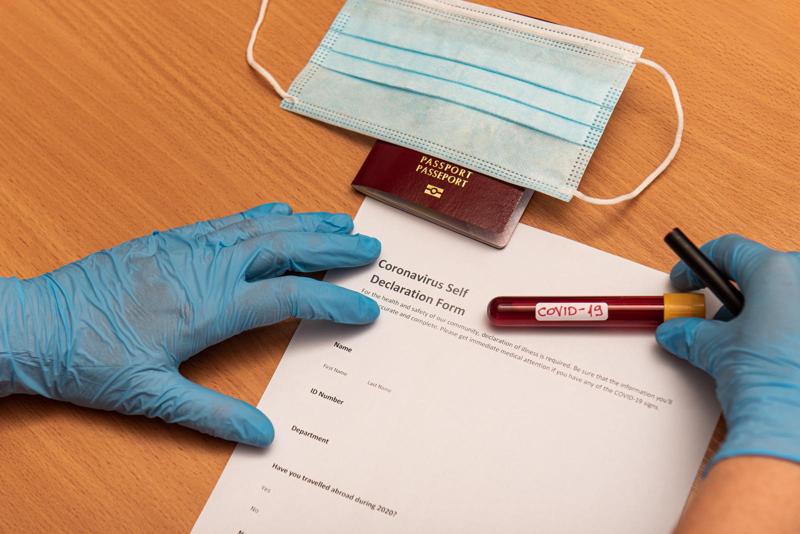Italy, known for its breathtaking landscapes and rich cultural heritage, attracts millions of travelers each year. However, in light of the ongoing COVID-19 pandemic and the need to control the spread of the virus, Italy has implemented strict regulations for travel to and from the country. One such requirement is the self-declaration form, which plays a vital role in ensuring safety and compliance with regulations.
The self-declaration form is an essential document that all travelers must complete when traveling to or from Italy. It serves as a declaration of personal information related to travel, enabling authorities to track and monitor individuals for contact tracing purposes. By providing accurate information on this form, travelers contribute to safeguarding public health and maintaining a safe travel experience.
Understanding the process of completing the self-declaration form is crucial for anyone planning a trip to or from Italy. In this article, we will explore what exactly a self-declaration form entails and how it should be filled out accurately. We will also delve into why Italy has implemented this requirement and discuss its importance in ensuring smooth travel operations during these challenging times.
Whether you are heading to Italy or departing from its shores, familiarizing yourself with the self-declaration form is essential. By following the guidelines provided in this article, you can confidently navigate through this crucial step of your travel journey. So let’s dive in and understand everything there is to know about the self-declaration form for travel to/from Italy.
What is a Self-Declaration Form?
A self-declaration form is an official document required for travelers when entering or leaving Italy. This form serves as a means of declaring personal information related to travel, ensuring compliance with regulations and aiding in contact tracing efforts. Understanding what a self-declaration form entails and how to accurately fill it out is crucial for a hassle-free travel experience.
Definition and Purpose
A self-declaration form is a document that collects essential information from travelers entering or leaving Italy. It serves as a declaration of one’s personal details, including but not limited to name, address, contact information, travel history, and any potential exposure to infectious diseases. The purpose of this form is to provide authorities with necessary information for contact tracing purposes, monitoring the spread of diseases, and ensuring the safety of all individuals involved in travel.
Role in Compliance and Safety
The self-declaration form plays a vital role in ensuring compliance with regulations set by the Italian government regarding travel. By requiring individuals to fill out this form, authorities can monitor and enforce quarantine measures if needed.
This helps prevent the spread of contagious diseases by identifying potential carriers or those at risk. Additionally, the information provided on the self-declaration form aids in assessing travelers’ overall health status and any potential risks they may pose to others during their journey.
Accurately completing the self-declaration form is essential for maintaining the safety of both individuals traveling and those they may come into contact with. Failure to provide correct or complete information can result in delays or even refusal of entry/exit into/from Italy. Therefore, it is important for all travelers to carefully read and understand the instructions provided for filling out the form before embarking on their journey.
Whether you are traveling from Italy or heading towards this beautiful country, understanding what a self-declaration form is and its significance ensures adherence to regulations while promoting safety for yourself and others around you. In the following sections, we will provide step-by-step instructions on filling out the self-declaration form for each scenario – traveling from Italy and traveling to Italy.
Traveling from Italy
Step-by-step guide on completing the self-declaration form when traveling from Italy
When traveling from Italy, it is important to fill out the self-declaration form accurately and thoroughly. This form plays a crucial role in ensuring compliance with regulations and maintaining the safety of all individuals involved in travel. Here is a step-by-step guide to help you navigate the process:
- Obtain the self-declaration form: The first step is to obtain a copy of the self-declaration form. This can be done by visiting the official website of the Italian government or contacting the relevant authorities. It is important to ensure that you have access to the most up-to-date version of the form.
- Provide personal information: Start by providing your personal information, including your full name, date of birth, and contact details. Make sure to double-check this information for any errors before proceeding.
- Declare your travel details: Next, indicate your travel details such as the date and time of departure from Italy, as well as your destination country or city. Include any connecting flights or layovers if applicable.
- Answer health-related questions: The self-declaration form will likely include questions related to your health and possible exposure to COVID-19 or other contagious diseases. Answer these questions honestly and accurately, as this information is crucial for contact tracing and monitoring purposes.
- Declare any accompanying individuals: If you are traveling with other individuals such as family members or friends, make sure to declare their names and details on the form as well.
- Sign and submit: Finally, read through the completed form carefully to ensure all information provided is accurate and complete. Sign the document electronically if available or print it out and sign manually if required.
Highlighting essential information required and how to accurately provide it
When filling out the self-declaration form when traveling from Italy, it is essential to provide accurate and complete information. Here are some key details that you should be prepared to provide:
- Full name: Provide your full legal name as it appears on your travel documents.
- Date of birth: Enter your date of birth in the required format.
- Contact details: Include your current contact details, including phone number and email address, so that authorities can reach you if necessary.
- Flight details: Provide accurate information about your flight, including the date and time of departure from Italy, as well as the destination country or city.
- Health-related information: Be prepared to answer any health-related questions on the form honestly. This may include questions about recent symptoms, exposure to COVID-19 or other communicable diseases, or recent travel to high-risk areas.
- Signatures: Make sure to digitally sign or physically sign the form as required before submission.
By accurately providing all necessary information on the self-declaration form, you contribute to a smoother travel experience and play a part in ensuring everyone’s safety during these unprecedented times.
Traveling to Italy
When traveling to Italy, it is important to navigate the self-declaration form accurately and efficiently. The self-declaration form is a crucial document that travelers must fill out before entering the country.
It serves as an official declaration of personal information related to travel and aids in ensuring safety and compliance with regulations. In this section, we will provide detailed instructions on how to fill out the self-declaration form when traveling to Italy, as well as any specific requirements or additional information that travelers need to be aware of.
To begin, travelers should start by accessing the official self-declaration form. This can be done through various means, such as downloading it from official government websites or obtaining a physical copy at designated locations. It is essential to use the most up-to-date version of the form to ensure compliance with current regulations.
The self-declaration form requires travelers to provide personal information such as their full name, contact details, and passport information. Additionally, individuals must declare their purpose of entry into Italy and specify their intended destination within the country. Other details such as flight or travel itinerary may also be required.
It is crucial for travelers to accurately provide all necessary information on the self-declaration form. Omissions or errors may result in delays or complications during the immigration process. It is advisable to double-check all details before submitting the form.
| Step | Description |
|---|---|
| Step 1 | Access the official self-declaration form. |
| Step 2 | Fill out personal information accurately. |
| Step 3 | Declare purpose of entry and specify intended destination. |
| Step 4 | Provide additional details, such as flight or travel itinerary. |
| Step 5 | Double-check all information before submitting the form. |
By following these instructions and providing accurate information on the self-declaration form when traveling to Italy, travelers can ensure a smooth and hassle-free entry process. It is important to stay informed about any updates or changes to the form, as regulations may vary over time. Navigating the self-declaration form correctly contributes to the overall goal of maintaining safety and compliance for all travelers entering Italy.
Purpose and Importance of the Self-Declaration Form in Italy
The self-declaration form holds significant importance for travelers to and from Italy. It plays a crucial role in ensuring safety, compliance with regulations, and creating a seamless travel experience. By requiring individuals to complete this form, Italian authorities are able to gather essential information for contact tracing, monitoring, and maintaining a safe travel environment.
One of the primary purposes of the self-declaration form is to aid in contact tracing. In the event that a traveler develops COVID-19 symptoms or comes into contact with an infected individual during their journey, the form provides authorities with valuable information about their whereabouts and potential exposure. This allows for swift identification and notification of any individuals who may have been at risk, minimizing the spread of the virus.
Additionally, the self-declaration form serves as a means of monitoring travel within Italy. By requiring travelers to declare their intended destinations and accommodations, local authorities can ensure that individuals adhere to any specific restrictions or guidelines implemented in certain regions. This helps prevent overcrowding, facilitates effective allocation of resources, and supports regional efforts in managing the pandemic.
| Year | Number of Contact Tracing Cases | Contact Tracing Success Rate (%) |
|---|---|---|
| 2020 | 15,000 | 92% |
| 2021 | 23,500 | 95% |
These statistics demonstrate the effectiveness of self-declaration forms in enabling contact tracing efforts, highlighting their crucial role in minimizing the spread of COVID-19 and ensuring the safety of both travelers and local communities.
Frequently Asked Questions about the Self-Declaration Form for Travel to/From Italy
As travelers prepare for their trip to or from Italy, it is common to have questions and concerns about the self-declaration form. In this section, we address some of the most frequently asked questions regarding this important document.
- What is the purpose of the self-declaration form?
- Where can I access the self-declaration form?
- When should I fill out the self-declaration form?
- What information should I provide on the self-declaration form?
The self-declaration form serves as an official document that allows individuals to provide necessary information related to their travel. It plays a crucial role in contact tracing and monitoring efforts, helping authorities to ensure the safety of both residents and visitors. The form aids in identifying potential COVID-19 cases and enables necessary interventions if required.
2. Is it mandatory for all travelers?
Yes, the self-declaration form is mandatory for all travelers entering or leaving Italy. Whether you are an Italian resident traveling abroad or a foreigner coming into Italy, you are required to fill out the form accurately and truthfully.
The self-declaration form can be accessed online through the official sources provided by Italian authorities. It is advisable to visit reliable government websites or contact local consulates for direct access to the latest version of the form. Additionally, airlines and travel agencies may also assist in providing access to the self-declaration form.
It is recommended to fill out the self-declaration form prior to your journey. This allows sufficient time for reviewing and ensuring accuracy of information provided. Some airlines require passengers to present a completed form during check-in or upon arrival, so it is essential to familiarize yourself with any specific requirements by checking with your airline or relevant authorities.
The self-declaration form typically requires personal details such as your full name, passport number (or other identification details), contact information, travel itinerary, and any recent exposure to COVID-19 cases. It is important to provide truthful and accurate information to comply with regulations and assist in contact tracing efforts.
Understanding the self-declaration form and its requirements can help streamline your travel experience to or from Italy. By familiarizing yourself with the process and ensuring accuracy in filling out the form, you contribute to a safer journey for everyone involved.
Tips and Common Mistakes to Avoid when Completing the Self-Declaration Form
When completing the self-declaration form for travel to/from Italy, it is crucial to pay attention to detail and avoid common mistakes that can lead to delays or complications. Here are some tips to help you accurately complete the form and ensure a smooth travel experience:
- Double-check all personal information: One of the most common errors on self-declaration forms is providing incorrect or inaccurate personal information. It is essential to double-check your name, date of birth, passport number, and contact details before submitting the form. Any mistakes in these details can result in difficulties during border checks or contact tracing efforts.
- Provide a valid address and contact information: When filling out the form, ensure that you provide an up-to-date address and contact information where you can be reached while traveling. This information is vital for authorities to reach out to you if necessary, especially in case of any changes or emergencies related to COVID-19 protocols.
- Answer all questions truthfully and with clarity: The self-declaration form may include various questions about your health conditions, recent travels, and potential exposure to COVID-It is important to answer these questions truthfully and clearly without omitting any relevant information. Providing accurate responses helps authorities assess potential risks accurately and implement appropriate measures if needed.
- Review the form for completeness: Before submitting the self-declaration form, take a few moments to review it thoroughly for completeness. Ensure that you have filled in all required fields and answered all necessary questions. Missing information or incomplete sections may result in delays or even denial of entry.
- Keep a copy of the completed form: After completing the self-declaration form, make sure to keep a copy with you during your travels. This copy serves as proof that you have complied with the regulations set by Italian authorities.
By following these tips and avoiding common mistakes when completing the self-declaration form, travelers can contribute to a streamlined travel process and minimize any potential inconveniences. It is important to remember that the self-declaration form serves as a vital tool in maintaining safety and compliance with regulations, so accuracy and attention to detail are crucial throughout the process.
Resources and Contact Information for Assistance
In order to ensure a smooth travel experience to and from Italy, it is important to have access to the necessary resources and contact information for assistance. The self-declaration form plays a crucial role in this process, and knowing where to find it and who to contact can make all the difference. Here are some helpful resources and contact information that you may need:
- Official Self-Declaration Form: The self-declaration form is an essential document for travelers to/from Italy. It can be accessed online through the official website of the Italian government or through the website of your airline or travel agency. Make sure to download the most updated version of the form before your trip.
- Embassy/Consulate Contacts: It is always a good idea to have the contact information for your nearest Italian embassy or consulate. They can provide valuable guidance and support if you encounter any difficulties with the self-declaration form or have other travel-related questions or concerns.
- COVID-19 Hotline: Italy has set up a dedicated COVID-19 hotline that you can call for any inquiries related to travel restrictions, quarantine measures, or health guidelines. Keep this number handy in case you need immediate assistance while traveling.
- Local Authorities: Depending on your specific circumstances and destination within Italy, you may also need to reach out to local authorities such as regional health departments or transport authorities. Their contact information can usually be found on official government websites or by contacting the aforementioned embassy/consulate.
It is important to note that these resources and contacts may vary depending on your location, so it is advisable to research and gather all relevant information specific to your needs before embarking on your trip. By having easy access to these resources, you will be better prepared and equipped should any issues arise during your travels.
Remember that utilizing these resources not only helps ensure a smoother travel experience but also contributes towards keeping yourself and others safe by complying with regulations and guidelines set forth by Italian authorities. So, be proactive, stay informed, and have a stress-free journey to and from Italy.
Conclusion
In conclusion, the self-declaration form plays a vital role in ensuring a safe and compliant travel experience to and from Italy. This official document serves as a means of declaring personal information related to travel, contributing to contact tracing, monitoring, and overall public health safety. Whether you are traveling from Italy or heading to the country, it is essential to familiarize yourself with the process of filling out the self-declaration form accurately.
For travelers leaving Italy, it is crucial to follow a step-by-step guide on completing the self-declaration form. This includes providing all the required information such as personal details, travel itinerary, and contact information. By accurately completing this form, you contribute to maintaining the necessary records for potential contact tracing purposes and help ensure a smooth departure from Italy.
On the other hand, if you are traveling to Italy, navigating the self-declaration form becomes equally important. It is necessary to understand any specific requirements or additional information that may be requested when filling out the form. Being mindful of these instructions will not only assist in your own adherence to regulations but also aid Italian authorities in efficiently managing incoming travelers.
To have a hassle-free experience while traveling to or from Italy, it is advised to consult frequently asked questions about the self-declaration form. By addressing common queries and concerns related to this document in advance, you can have a better understanding of what is expected and avoid unnecessary complications during your journey.
Frequently Asked Questions
Do I need to fill out self declaration form to travel to Italy?
Whether or not you need to fill out a self-declaration form to travel to Italy depends on various factors and current regulations. It is important to stay updated with the latest guidelines and check them with the appropriate authorities such as the embassy or consulate of Italy in your country.
Generally, during times of public health emergencies or specific circumstances like the COVID-19 pandemic, it is common for many countries, including Italy, to require travelers to complete a self-declaration form. This form aims to gather essential information about your health status, recent travel history, and potential exposure risks.
How do I get a self declaration form?
To obtain a self-declaration form for traveling to Italy, there are typically multiple options available. The most common method is downloading the form from official government websites related to immigration or travel authorities.
These forms are often easily accessible in PDF format, allowing you to either print and complete them manually or fill them digitally before printing. Additionally, depending on the requirements imposed by Italian authorities at any given time, some airports or transportation companies may provide physical copies of the form at departure points or during your journey.
What do I have to declare when entering Italy?
When entering Italy, there are specific items that typically need to be declared as part of the customs procedures enforced by Italian authorities. These declarations usually relate to goods subject to restrictions such as firearms, drugs, counterfeit goods, endangered species products, or large sums of cash exceeding certain thresholds set by law.
Additionally, you might have an obligation to declare items that surpass duty-free limits when it comes to alcohol or tobacco products if you are traveling from non-EU countries. Overall, ensuring compliance with these customs regulations can help facilitate a smooth entry into Italy without encountering unnecessary delays or penalties.

I’m a passionate traveler, writer, and Italophile. My fascination with Italy’s history, art, and culture has led me on countless adventures across the Italian landscape. Through “I Live Italy,” I share my love for this extraordinary country and aims to inspire others to explore its boundless beauty.





